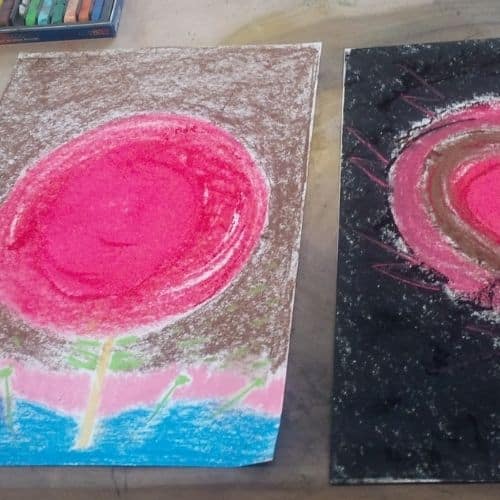
What does an art therapy session look like—and who would benefit from art therapy?
Art therapy can be messy, contained, or anything in between–it’s up to you. Just as there are innumerable genres in music, there are an unlimited number of aesthetic and theoretical approaches in art and art therapy.
Working from your home art studio, you may find yourself painting with water colours or finger paints in your virtual art therapy session. You may choose to create with fabric, string or yarn, brightly coloured tissue paper, found objects from nature, or modelling clay. You may draw with ink or charcoal. You might even deconstruct and reconstruct a set of old lawn chairs. Art materials do not have to be expensive to allow for highly expressive work.
I offer a diverse range of art materials in my studio if you prefer in person sessions.
Sessions typically begin with a check in and finish with some form of verbal processing. The art making is comfortably sandwiched between these two elements.
Are there special populations who might benefit from art therapy?
Art therapy has been shown to be effective for participants with issues including anxiety, depression, life transitions, grief, trauma, and many other mental health concerns. There are art therapists who specialize in working with individuals, couples and families, or youth and children. Some therapists–like me–also facilitate group workshops for schools and other organizations.
In addition, there are increasing numbers of therapists who specialize in working with BIPoC and/or LGBTQ2S+ people. As a white, cis, heterosexual therapist, I believe gender and sexuality are fluid and that we benefit from all forms of diversity in our communities and in society as a whole. I also explicitly acknowledge that the systems and society I work within can be oppressive in multiple, overlapping ways. As such, I see therapy and social justice activism as inextricably intertwined, and I strive to mitigate harm for my participants by providing appropriate support and links to helpful resources whenever possible.
Furthermore, as a professional art therapist, I will continue to work with a supervisor (just as I have done as a student) to interrogate my therapeutic process and maximize my effectiveness. Congruent with Narrative Therapy principles, my participants can request case conferences during which all three of us will discuss particularly challenging participant material. Through this approach, we will all learn how we can become increasingly effective in our work, together.
Contact me at hello@ebbandflowarttherapy.ca to see how art can play a role in your healing journey.
This content has been revised from a blog originally created by me for the Welling Centre in 2020.

Jillian Paschen
Jillian Paschen is passionate about art and human interactions. She earned her Master of Psychotherapy and Spirituality--Art Therapy degree from St Stephen's College at the University of Alberta, and sees clients as a professional Art Therapist and Canadian Certified Counsellor (CCC). Jillian co-founded a free community initiative--Ebb & Flow Art Hive--that has been active since 2016, and available online since March 2020. Jillian also offers expressive arts workshops for students of all ages in the Greater Edmonton area. Contact: hello@ebbandflowarttherapy.ca > read more
